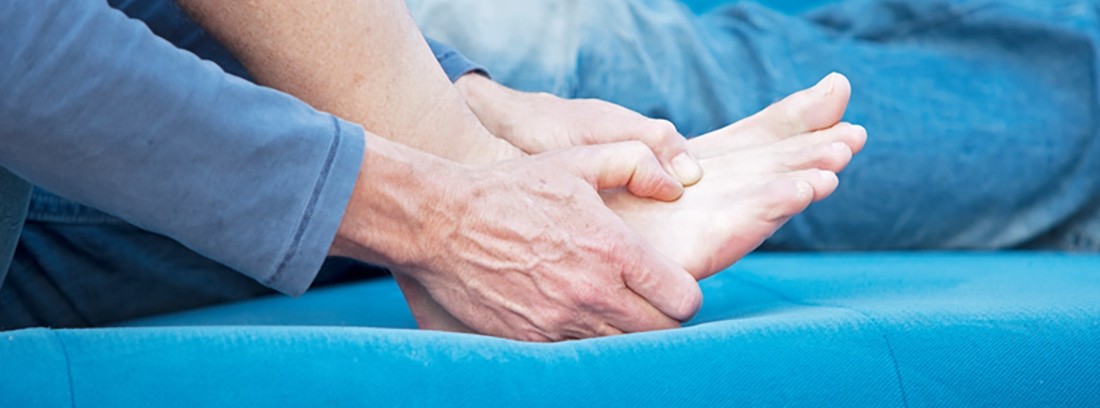Gout

It is a disease characterized by the deposit of monosodium urate crystals in the joint cavity preferably.
How is it produced?
It is the result of high levels of uric acid (hyperuricemia) in the blood, although not all patients with hyperuricemia have gout. The probability of suffering from gout increases as the levels of uric acid in the blood increase as well as the presence of other factors.
Uric acid is the result of purine catabolism in man. Uric acid levels increase by two mechanisms:
Increased uric acid production. By causes genetic: enzyme defects or causes acquired: diet rich in purines, obesity, alcohol, chemotherapy and neoplasms.
Decreased renal elimination of uric acid (it is the most common mechanism: 90%). By causes genetic: Polycystic kidney disease, Down syndrome or causes acquired: Drugs: diuretics, low-dose acetylsalicylic acid, ethambutol, cyclosoporine, nicotinic acid; endocrine diseases (hypothyroidism, hyperparathyroidism), dehydration, prolonged fasting or postsurgical.
Hyperuricemia is considered when uric acid values are greater than 7 mg / dl. Uric acid levels before puberty are very low. After puberty, boys reach levels that will be maintained throughout life. In women, uric acid levels remain low until menopause, a period in which they increase, approaching the level of men. It is common to find several members of the same family with hyperuricemia, probably due to the existence of genetic factors.
Symptoms
Gout crisis: it is the most frequent manifestation. It consists of the presence of acute inflammation of a joint (in half of the cases it originates in the big toe, the classic podagra) causing intense pain, onset in the evening that increases with mobility, along with redness in the area. with subsequent desquamation. At other times, the pain is less severe and lasts longer. After starting treatment or spontaneously, the crisis subsides completely and the patient remains asymptomatic.
These crises can be repeated in the same joint or in others. Drug treatment makes the episodes less frequent, less intense and of shorter duration. The joints that are most frequently affected are, in addition to the base of the big toe, the ankle, knee, wrist or some joint of the fingers, as well as the elbow or the Achilles tendon. Certain triggers can initiate gout attacks such as alcohol abuse, food intake, local trauma or after surgery.
Tophaceous gout: Tophi are aggregates of urate crystals that appear after a long evolution of the disease. They are located mainly in the elbows, hands, feet or in the pinna. Its presence indicates a late treatment of the disease or an incorrect treatment of it.
Diagnosis
The presence of monosodium urate acid crystals in synovial fluid and tophi, obtained by intramuscular needle aspiration, is decisive for the diagnosis of gout.
However, the presence of repeated attacks of gout in the same patient, in the same location and with elevated uric acid levels, are diagnostic of gout. In the case of different locations or patients with other underlying diseases, the differential diagnosis will be made with other rheumatological diseases such as chondrocalcinosis, spondyloarthropathies, psoriatic arthritis as well as dermatological diseases, mainly cellulitis.
Radiology plays a scarce role in diagnosis since urate crystals are transparent to X-rays. Only the appearance of tophi in the joints produces a lesion that can be seen on radiography.
Treatment
It is based on the treatment of the acute attack, the prevention of new gout attacks and the reduction of hyperuricemia.
1. Treatment of the acute episodeResponse to treatment is faster the earlier treatment is started. It consists of resting the joint and the administration of NSAIDs at the maximum recommended doses to gradually decrease them after 48 hours until they are withdrawn. indomethacin is the NSAID of choice. Colchicine has been the drug of choice for many years, but the appearance of diarrhea as a side effect has relegated it to the background, indicating it in cases of the use of NSAIDs inadvisable.
2. Prevention of new attacksIt is performed with low doses of colchicine daily (or every other day if it is not well tolerated), achieving the total disappearance of gout attacks. It does not reduce uric acid levels in the blood, so it would be indicated while the treatments aimed at reducing hyperuricemia are being established, keeping the patient asymptomatic. Low-dose NSAIDs are also used if there is a contraindication to colchicine.
3. Decrease in hyperuricemia
It is indicated for repeated attacks (> 2 / year), in tophaceous gout and in secondary gout (to diuretics, for example). Always after the acute episode resolved and the patient doing preventive treatment initially. It is also recommended the reduction of alcohol consumption as well as a low calorie diet avoiding overweight. Among the drugs used are allopurinol, which reduces uric acid formation, and the so-called uricosuric drugs that promote the renal elimination of uric acid.
Asymptomatic hyperuricemia (uric acid levels> 7 mg / dl without gouty attacks) is not treated, a low-purine diet and avoiding alcohol are recommended.
Foods rich in uric acid
Organ meats (liver, kidney, brains, kidneys, tongue), anchovies, sardines and trout.
(Updated at Apr 14 / 2024)